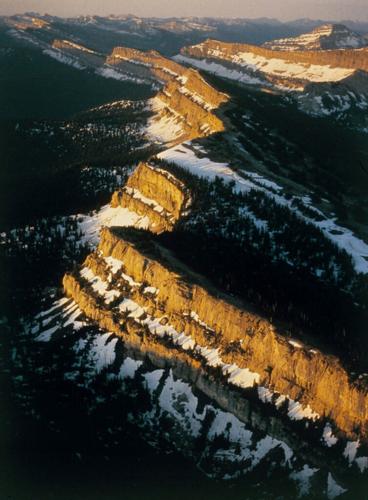To place the Chinese Wall in the southwest Montana tourism region might seem a bit odd as it is located in the northwest quadrant of the state. However, it is in Lewis & Clark County, part of Montana’s southwest tourism designation. And the county extends well beyond the bounds of a geographic region, transcending two of them.
Specifically, the wall lies in the Bob Marshall Wilderness, one of three contiguous protected regions of the Bob Marshall Complex. The other two are the Great Bear and Scapegoat wilderness areas.
A 13-mile-long piece of unique geography carrying the Continental Divide along its crest best describes this iconic landmark. From Larch Hill Pass in the north to White River Pass on south, the Chinese Wall it is an unbroken natural masterpiece.
Its east face is an escarpment rising upwards of 1,000 feet from meadows at its base. In geologic terms this is textbook overthrust geology — older rocks pushed up and over younger rocks. This massif of limestone was pushed eastward and upwards tilting as it rose, leaving its west side sloping somewhat “gently” downward. It is easily seen and recognized from any high point to the east.
Rocks of the uplift are amongst the oldest on the planet — Precambrian and contain marine life fossils dating back millions of years ago. Once they were sediments in an inland sea and as the sea disappeared, deposits of millions upon millions of shells, sand and silt hardened to limestone.
To many, a trek to the Chinese Wall is a life-long wish. Whether by horse or on foot, getting to this place deep in the heart of true wilderness is a rewarding experience. The many passages that lead to it provide a journey through some of the finest wild country in America: “...the cathedral hush of the Bob.”
Many communities serve as a starting point to access the east face of the formation but Augusta, Lincoln and Ogando are recommended. Check on the Internet for trails to the Chinese Wall.









(0) comments
Welcome to the discussion.
Log In
Keep it Clean. Please avoid obscene, vulgar, lewd, racist or sexually-oriented language.
PLEASE TURN OFF YOUR CAPS LOCK.
Don't Threaten. Threats of harming another person will not be tolerated.
Be Truthful. Don't knowingly lie about anyone or anything.
Be Nice. No racism, sexism or any sort of -ism that is degrading to another person.
Be Proactive. Use the 'Report' link on each comment to let us know of abusive posts.
Share with Us. We'd love to hear eyewitness accounts, the history behind an article.